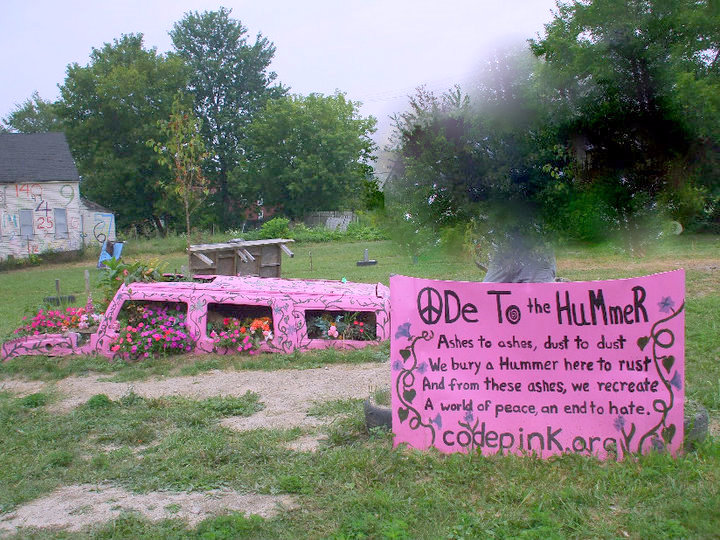This is a cache dedicated to the never-ending reworking and rebuilding of the world-famous Heidelberg Project that occupies this unique portion of the City of Detroit.
BE AWARE OF YOUR SURROUNDINGS HERE. Thank You.

Artist Tyree Guyton
The Heidelberg Project is an outdoor project in Detroit. It was created in 1986 by artist Tyree Guyton and his grandfather Sam Mackey (“Grandpa Sam”) as a public art environment in the McDougal-Hunt neighborhood on the city’s east side. The Heidelberg Project is, in part, a political protest, as Tyree Guyton’s childhood neighborhood began to deteriorate after the 1967 riots. Following his stint in the Army, Tyree Guyton described coming back to Heidelberg Street. He was astonished to see that the surrounding neighborhood looked as if “a bomb went off”.

How did those baskets get on top of the tree?
At first, the project consisted of his painting a series of houses on Detroit’s Heidelberg Street with bright dots of many colors, and attaching salvaged items to the houses. It was a constantly evolving work that transformed a hard-core inner-city neighborhood where people were afraid to walk, even in daytime, into one in which neighbors took pride and where visitors were many and welcomed.

Heidelberg Street, 1980's
Tyree Guyton worked on The Heidelberg Project every day with the children on the block. The main goal was to develop The Heidelberg Project into the city’s first indoor and outdoor museum, complete with an artists’ colony, creative art center, community garden, amphitheater, and more.
The effect of the Heidelberg Project is displayed through the development of Heidelberg Street. At the other end of the street, there are crumbling houses with lawns covered with waist-high weeds, rubble and rubbish, with no people in sight. Nevertheless, the Heidelberg Project attracts nearly 275,000 visitors a year, now considered a recognized destination for Detroit tourists

Marching vacuum cleaners
On two occasions, the Heidelberg Project faced complete and total total destruction by the City of Detroit due to the barriers in urban planning it represented. In November 1991, under Mayor Young, the Heidelberg Project’s “The Baby Boy House,” “Fun House” and “Truck Stop” were completely demolished. Under Mayor Archer a second demolition of the Heidelberg Project was ordered on February 4, 1999 that ended in the destruction of the houses Guyton termed “Your World,” “Happy Feet” and “The Canfield House.” The 1999 demolition did, however, result in Guyton and his supporters’ bringing a civil lawsuit against the City of Detroit. The Wayne County Circuit Court ruled that the Heidelberg Project was protected “political speech” under the 1st amendment as an outdoor art environment.

Partial Demolition, 1999
Today, the Heidelberg Project is recognized around the world as a demonstration of the power of creativity in creating hope and a bright vision for the future. The houses that remain on Heidelberg st. include the “Dotty-Wotty”, “The House that Makes Sense”, “Numbers House” and the “House of Words”, along with the Detroit Industrial Gallery, an artist studio/home that was purchased and maintained by Detroit artist Tim Burke.

More Art
The Heidelberg Project hopes to offer a new approach to the growing problems of urban sprawl facing many American and other international ‘shrinking cities’. This approach has garnered international attention, especially as the Heidelberg Project continues its maturation. The 20th Anniversary of the Heidelberg Project was celebrated on August 26, 2006 with a free community festival, an event that capped a year of special attention.

The Cache... is here. ;-)
Again, enjoy the hunt for this, along with the art that is here.
BE AWARE OF YOUR SURROUNDINGS HERE.
PLEASE KEEP IN MIND,
SOME HOMES HERE
ARE NOT PART OF
THE HEIDELBERG PROJECT...thank you.
This Cache CAN be done 24 hours/day, however, it is recommended
during DAYLIGHT hours for full enjoyment of the area.